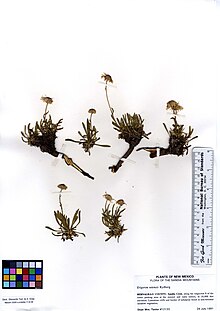Professional herbs
| Professional herbs | ||||||||||||
|---|---|---|---|---|---|---|---|---|---|---|---|---|
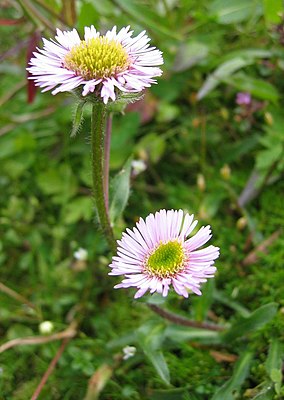
Bald fleabane ( Erigeron glabratus ) |
||||||||||||
| Systematics | ||||||||||||
|
||||||||||||
| Scientific name | ||||||||||||
| Erigeron | ||||||||||||
| L. |
The erigeron ( Erigeron ) constitute a genus within the family of Compositae (Asteraceae). The almost worldwide up to 400 species are mainly distributed in the temperate areas of the northern hemisphere ( Holarctic ) and especially in North America (173 species). Only nine species are native to Central Europe.
description





Appearance and leaves
Erigeron species are annual or perennial herbaceous plants , some species are evergreen. The stems are erect or prostrate. The leaves are always alternate , in many species the leaves are in a basal rosette. The leaf blades are whole, toothed to divided.
Inflorescences, flowers and fruits
The flower heads stand individually or to a few, rarely to several. The diameter of the flower heads is 5 to 35 millimeters. The bracts are in two or three series, narrow and herbaceous to dry. The bottom of the basket is flat or convex and bare. The occupational herbs have tubular and ray flowers . On the outside, in one or more rows, the rarely missing, mostly 12 to 350 ray-flowers (= ray-flowers) are white to red-brownish in color and almost twice as long as the tubular flowers and spread outwards; they are feminine and fertile . The 25 to 450 tubular flowers (= disc flowers) are hermaphroditic, fertile. There are usually much more disc flowers than ray flowers. The corolla tube is usually yellow and the five corolla lobes are sometimes purple.
The achenes are mostly narrow ellipsoidal to ovoid, sometimes compressed. The pappus is usually double, the outer row usually scaly or missing, the inner row fine. Very rarely the pappus is completely absent.
Sets of chromosomes
The basic chromosome number is x = 9. In the genus Erigeron is polyploidy often, often accompanied by Agamospermy , especially in species with odd-ploidy.
Differences between Conyza and Erigeron
The distinguishing features between the two genera, which are known as “professional herbs” and have often been combined under Erigeron since the results of molecular genetic studies, are not always clear. Usually Conyza has asymmetrical bracts and 2 to 20 times as many female as hermaphrodite flowers in each cup, rarely more hermaphroditic than female. The crown of the female flowers usually have no tongue or it is at least shorter than a millimeter. The genus Erigeron has approximately symmetrical bracts and more hermaphroditic than female flowers. The crown of the female flowers usually has a tongue 2 to over 10 millimeters in length.
Plant diseases
Various types of Erigeron are attacked by the rust fungi Puccinia cnici-oleracei and Puccinia dovrensis .
Systematics and distribution
The genus Erigeron was in 1753 by Linnaeus in Species Plantarum erected . The botanical genus name Erigeron is made up of the Greek words eri for "early" or erio for "woolly" and geron for "old man" and refers to the "white hair" of the fruits that appears soon after the flowering period . Synonyms for Erigeron L. are: Achaetogeron A. Gray , Trimorpha Cass.
Depending on the source, the genus Erigeron (200 to) 390, if the genus Conyza is included, contains up to 400 species. The high and strongly fluctuating numbers are typical for agamosperm clans . According to molecular genetic studies, the genus is likely to be paraphyletic , as the genera Conyza (25 to 60 species), Aphanostephus (four species) and the South American Leptostelma group are within the monophyletic group of Conyzinae .


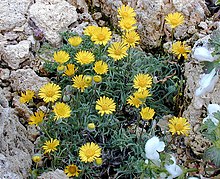




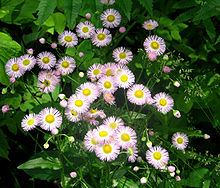
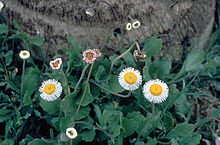




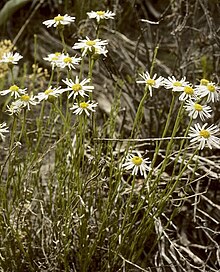
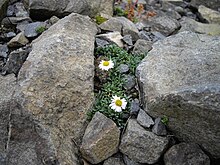


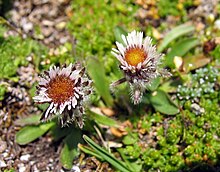

The Erigeron species (excluding the Conyza species) are:
- Erigeron abajoensis Cronquist : It thrives at altitudes of (2000 to) mostly 2800 to 3500 meters only in the southern US states of Arizona , New Mexico and Utah .
- Erigeron acomanus Spellenb. & P.Knight : It thrives only in New Mexico at altitudes of 2,000 to 2,300 meters.
- Hot Fleabane ( Erigeron acris L. )
- Erigeron adenophorus Greenm.
- Erigeron aegyptiacus L.
- Erigeron aequifolius H.M.Hall : It thrives in altitudes from 1,500 to 2,500 meters in California .
- Erigeron affinis DC.
- Erigeron alexeenkoi (Krasch.) Botsch.
- Erigeron algidus Jeps. : It thrives at altitudes of 2600-3700 meters in California and Nevada .
- Erigeron aliceae Howell : It occurs in Washington , Oregon and California.
- Erigeron allochrous botsch. : It occurs in Kazakhstan as well as in Ürümqi in northern Xinjiang .
- Erigeron allocotus S.F.Blake : It occurs in Montana and Wyoming .
- Erigeron alpiniformis Cronquist : It only occurs in Greenland .
- Alpine fleabane ( Erigeron alpinus L. ): It occurs in central and southern Europe , in western Asia , Ethiopia and Kenya .
- Erigeron altaicus Popov
- Erigeron altissimus R.R. Stewart
- Erigeron anchana G.L. Nesom : It occurs in Arizona .
- Erigeron andicola DC.
- Erigeron androssovii Popov
- Erigeron angustissimus Lindl. ex DC.
- Erigeron anisophyllus Rech. F.
- Erigeron annuactis G.L.Nesom
- Annual fine ray or annual fleabane ( Erigeron annuus (L.) Pers. ), A neophyte from North America .
- Erigeron aphanactis (A.Gray) Greene : It occurs in two varieties in the western United States.
- Erigeron apiculatus Benth.
- Erigeron aquarius Standl. & Steyerm.
- Erigeron arenarioides (DCEaton ex A.Gray) A.Gray ex Rydb. : It thrives at altitudes of 1,300 to 3,600 feet in Utah only.
- Erigeron argentatus A.Gray : It occurs in Arizona, Utah, California and Nevada.
- Erigeron arisolius G.L.Nesom : It comes in Arizona and in Mexico before.
- Erigeron arizonicus A.Gray : It occurs in Arizona, New Mexico and northern Mexico.
- Erigeron armerifolius Turcz. ex DC.
- Erigeron asperugineus (DCEaton) A.Gray : It is found in Idaho, Montana, Nevada and Utah.
- Erigeron astranthioides DeJong & GLNesom
- Glandular fleabane ( Erigeron atticus Vill. ): It occurs in Central and Southern Europe and in Turkey.
- Orange-colored fleabane ( Erigeron aurantiacus rule ): It occurs in Central Asia in Kazakhstan , Kyrgyzstan and in the Chinese Xinjiang .
- Gold Fleabane ( Erigeron aureus Greene ): It is common in Alberta , British Columbia, and Washington.
- Erigeron aviatorum Herter
- Erigeron azureus rule ex Popov
- Erigeron badachschanicus Botsch.
- Erigeron baicalensis Botsch.
- Erigeron barbellulatus Greene : It thrives at altitudes of 2100 to 3300 meters in California.
- Erigeron bardsirica Parsa
- Erigeron basalticus Hoover : It occurs only in the northwestern US state of Washington .
- Erigeron basaseachensis G.L.Nesom
- Erigeron basilobatus S.F.Blake
- Erigeron baumii O. Hoffm.
- Erigeron bellidiastroides Griseb.
- Erigeron bellidiastrum Nutt. : It is distributed in three varieties from the USA to northern Mexico.
- Erigeron bellidiformis Popov
- Erigeron bellidioides (Buch.-Ham. Ex D.Don) Benth. ex CBClarke
- Erigeron bellioides DC.
- Erigeron bigelovii A.Gray : It occurs in Mexico, New Mexico and Texas .
- Erigeron bilbaoanus (Remy) Cabrera
- Erigeron biolettii Greene : It occurs in California.
- Erigeron biramosus Botsch.
- Erigeron blakei Cabrera
- Erigeron blochmaniae Greene : It occurs in California.
- Erigeron bloomeri A.Gray : It occurs in two varieties in the western United States.
- Erigeron boergeri Herter
- Erigeron bonariensis L.
- Nordic fleabane ( Erigeron borealis (Vierh.) Simmons ): It is common in Europe in Scandinavia , Iceland , Russia and the United Kingdom .
- Erigeron brachysperm botsch.
- Erigeron breviscapus (Vaniot) Hand.-Mazz.
- Erigeron breweri A.Gray : It occurs in five varieties in the western United States.
- Erigeron burejensis Barkalov
- Erigeron × burnati F.O.Wolf
- Erigeron byei S.D.Sundb. & GLNesom
- Erigeron cabulicus (Boiss.) Botsch.
- Erigeron caeruleus Urb.
- Erigeron caespitans com.
- Erigeron caespitosus Nutt. : It is widespread in Canada and the United States.
- Erigeron calcicola Greenm.
- Erigeron calderae A.Hansen
- Erigeron calvus Coville : It was only collected once in California.
- Erigeron campanensis Valdeb., Lowrey & Stuessy
- Erigeron camposportoi Cabrera
- Erigeron canaani S.L.Welsh : It occurs in Utah.
- Canadian Fleabane ( Erigeron canadensis L. ): It is widespread in North America and an invasive plant in many areas of the world .
- Erigeron canus A.Gray : It is found in the western and central United States and in northern Mexico.
- Erigeron capillipes Ekman ex Urb.
- Erigeron cascadensis A.Heller : It occurs in Oregon.
- Erigeron caucasicus Steven : It occurs in two subspecies in Turkey, Iran, Armenia, Azerbaijan, Georgia and in the Caucasus region.
- Erigeron caulinifolius G.L.Nesom
- Erigeron cavernensis S.L.Welsh & NDAtwood : It thrives at altitudes of 2100 to 3400 meters in Nevada.
- Erigeron cedretorum Rech. F.
- Erigeron celerieri Emb. & Maire
- Erigeron cervinus Greene : It occurs in Oregon and California.
- Erigeron chiangii G.L. Nesom
- Erigeron chihuahuanus Greene
- Erigeron chionophilus Wedd.
- Erigeron chiriquensis Standl.
- Goldaster fleabane ( Erigeron chrysopsidis A.Gray ): It is common in three varieties in the western United States.
- Erigeron cieloensis G.L.Nesom
- Erigeron cilicicus Boiss. ex Vierh.
- Erigeron cinereus Hook. & Arn.
- Erigeron circulis G.L.Nesom
- Erigeron clokeyi Cronquist : It occurs in two varieties in the western United States.
- Erigeron coeruleus Popov
- Erigeron compactus S.F. Blake : It occurs in California, Nevada and Utah at altitudes between 1300 and 2900 meters.
- Split-leaved fleabane ( Erigeron compositus Pursh ): It is common in Alaska, Canada, the United States, and Russia's Far East.
- Erigeron concinnus (Hook. & Arn.) Torr. & A.Gray : It is common in three varieties in the western United States and New Mexico.
- Erigeron consimilis Cronquist : It occurs in Arizona, Colorado and Utah.
- Erigeron conyzoides F. Muell.
- Erigeron coronarius Greene
- Erigeron coroniglandifer G.L. Nesom
- Erigeron corymbosus Nutt. : It occurs in British Columbia and the western United States.
- Erigeron coulteri Porter : It occurs in the western United States at altitudes between 1,800 and 3,700 meters.
- Erigeron crenatus Eastw.
- Erigeron cronquistii Maguire : It thrives at altitudes of 1,600 to 3,000 meters in Utah.
- Erigeron cuatrocienegensis G.L.Nesom
- Erigeron cyanactis Rech. F.
- Erigeron dactyloides (Greenm.) GLNesom
- Erigeron daenensis Vierh.
- Erigeron darrellianus Hemsl.
- Erigeron daveauanus (Sennen) Greuter
- Erigeron davisii (Cronquist) GLNesom : It occurs in Idaho and Oregon.
- Erigeron deamii B.L.Rob.
- Erigeron decumbens Nutt. : It occurs in Oregon.
- Erigeron dejongii G.L.Nesom
- Erigeron delphinifolius Willd.
- Erigeron denalii A.Nelson : It occurs in Alaska and western Canada.
- Erigeron diplopappoides S.Schauer
- Erigeron disparipilus Cronquist : It occurs in Washington, Oregon and Idaho.
- Erigeron dissectus Urb.
- Erigeron divergens Torr. & A.Gray : It is found in western Canada, western and central United States, and northern Mexico.
- Erigeron dolichostylus Botsch.
- Erigeron domingensis Urb.
- Erigeron droebachensis O.F. Garbage. ex Retz.
- Erigeron dryophyllus A. Gray
- Erigeron eatonii A.Gray : It occurs in six varieties in the western United States.
- Erigeron ecuadoriensis Hieron.
- Erigeron elatior (A.Gray) Greene : It thrives at altitudes of 2,400 to 3,800 meters in the US states of Colorado, Wyoming, Utah and New Mexico.
- Erigeron elatus (Hook.) Greene : It is widespread in Alaska, Canada and Washington.
- Erigeron elbursensis Vierh.
- Erigeron elegantulus Greene : It occurs in Oregon and California.
- Erigeron elmeri (Greene) Greene : It occurs in California at altitudes of 1,300 to 3,300 meters.
- Erigeron engelmannii A. Nelson : It thrives at altitudes of 1,300 to 2,500 meters in Colorado, Utah, Wyoming, and Idaho.
- Erigeron epiroticus (Vierh.) Halácsy
- Erigeron eriocalyx (Ledeb.) Vierh.
- Erigeron eruptens G.L.Nesom
- Erigeron ervendbergii A. Gray
- Erigeron evermannii Rydb. : It thrives at altitudes of 2,400 to 3,500 meters in Idaho and Montana.
- Erigeron exilis A. Gray ex A. Gray
- Erigeron eximius Greene : It thrives at altitudes of 2,300 to 3,500 meters in Arizona, Colorado, New Mexico, Utah, Wyoming, and Texas.
- Erigeron falconeri (CBClarke) Botsch.
- Erigeron fasciculatus Colla
- Erigeron fernandezius (Colla) Harling
- Erigeron filifolius (Hook.) Nutt. : It occurs in southern British Columbia and the western United States.
- Erigeron flabellifolius Rydb. : It thrives at altitudes of 2,800 to 3,800 meters in Wyoming and Montana.
- Erigeron flaccidus (Bunge) Botsch.
- Erigeron flagellaris A.Gray : It is found in western Canada, western and central United States, and northern Mexico.
- Erigeron flettii G.N.Jones : It only thrives in Washington at altitudes of 1500 to 3200 meters.
- Erigeron floribundus (Kunth) Sch.Bip.
- Erigeron fluens G.L. Nesom
- Erigeron foliosus Nutt. : It occurs in five varieties in California and northwestern Mexico.
- Erigeron formosissimus Greene : It occurs in two varieties in the western and central United States.
- Erigeron forreri (Greene) Greene
- Erigeron fragrans Spreng.
- Erigeron frigidus Boiss. ex DC.
- Erigeron fuertesii Urb.
- Erigeron fukuyamae Kitam. : It thrives only in Taiwan at altitudes of 1,800 to 3,000 meters.
- Erigeron fundus G.L.Nesom
- Erigeron galeottii (A.Gray) Greene
- Erigeron garrettii A.Nelson : It thrives at altitudes of 2,700 to 3,800 meters in Utah.
- Erigeron geiseri Shinners : It occurs in Oklahoma and Texas.
- Erigeron gilliesii (Hook. & Arn.) Cabrera
- Erigeron glabellus Nutt. : It occurs in two varieties in Alaska, Canada, and the United States.
- Bald fleabane ( Erigeron glabratus Hoppe & Hornsch. Ex Bluff & Fingerh. ): It is widespread in Central and Southern Europe.
- Erigeron glacialis (Nutt.) A. Nelson : It occurs in two varieties in Alaska, Canada, New Mexico, and the central and western United States.
- Erigeron glaucus Ker Gawl. : It occurs in Oregon and California.
- Erigeron gnaphalioides Kunth
- Erigeron goodrichii S.L.Welsh : It thrives at altitudes of 2200 to 3500 meters in Utah.
- Erigeron gouanii L.
- Erigeron gracilis Rydb. : It thrives at altitudes of 2,000 to 2,400 meters in Idaho, Montana, and Wyoming.
- Erigeron gramineus L.
- Erigeron granatensis W. Lippert
- Erigeron grandiflorus Hook. : It thrives at elevations of 2,900 to 4,200 feet in Alberta , British Columbia, Arizona, Colorado, Idaho, Montana, New Mexico, Oregon, Utah, and Wyoming.
- Erigeron greenei G.L. Nesom : It occurs in California.
- Erigeron griseus (Greenm.) GLNesom
- Erigeron guatemalensis (SFBlake) GLNesom
- Erigeron gunnii (Hook. F.) F.Muell.
- Erigeron gypsoverus G.L.Nesom
- Erigeron heliographis G.L.Nesom : It only thrives in Arizona at altitudes of 2500 to 3200 meters.
- Erigeron hessii G.L.Nesom : It thrives in altitudes from 2900 to 3100 meters just in New Mexico.
- Erigeron heterochaeta botsch.
- Erigeron heteromorphus B.L.Rob.
- Erigeron heterophyllus Muhl. ex Willd.
- Erigeron Hillii Domke
- Erigeron himalajensis Vierh.
- Erigeron hintoniorum G.L. Nesom
- Erigeron hispanicus (Vierh.) Maire
- Erigeron hissaricus botsch.
- Erigeron howellii (A.Gray) A.Gray
- Erigeron hultenii Spongberg
- Lower Fleabane ( Erigeron humilis Graham ): It is common in North America , Northern Europe, and Northeast Asia.
- Erigeron hungaricus (Vierh.) Pawł.
- Erigeron hyoseroides Griseb.
- Erigeron hyperboreus Greene
- Erigeron hypsophilus Phil.
- Erigeron hyrcanicus Bornm. & Vierh.
- Erigeron hyssopifolius Michx.
- Erigeron illapelinus Phil.
- Erigeron incaicus Solbrig
- Erigeron incertus (d'Urv.) Skottsb.
- Erigeron ingae Skottsb.
- Erigeron inoptatus A. Gray
- Erigeron inornatus (A.Gray) A.Gray
- Erigeron ivifolius (L.) Sch.Bip.
- Erigeron jaeschkei Vierh.
- Erigeron jamaicensis L.
- Erigeron janivultus G.L.Nesom
- Erigeron jenkinsii G.L. Nesom
- Erigeron Jonesii Cronquist
- Erigeron kachinensis S.L.Welsh & Gl.Moore
- Mexican fleabane, wall daisy ( Erigeron karvinskianus A.DC. ): It is naturally widespread from Mexico to Central and South America as well as in Kenya , Tanzania and Uganda and is a neophyte in many areas of the world .
- Erigeron khorossanicus Boiss.
- Erigeron kiukiangensis Ling & YLChen
- Erigeron klamathensis (GLNesom) GLNesom
- Erigeron komarovii Botsch.
- Erigeron kopetdaghensis Popov
- Erigeron krylovii Serg.
- Erigeron kumaunensis (Vierh.) Wendelbo
- Erigeron kunshanensis Ling & YLChen
- Erigeron kuschei Eastw.
- Erigeron lachnocephalus Botsch.
- Erigeron lackschewitzii G.L.Nesom & WAWeber
- Erigeron lanatus Hook.
- Erigeron lanceolatus Wedd.
- Erigeron lanuginosus Y.L.Chen
- Erigeron Lassenianus Greene
- Erigeron latus (A.Nelson & JFMacbr.) Cronquist
- Erigeron laxiflorus Baker
- Erigeron lechleri Sch.Bip.
- Erigeron leibergii Piper
- Erigeron leiolepis Solbrig
- Erigeron leiomerus A. Gray
- Erigeron leioreades Popov
- Erigeron lemmonii A. Gray
- Erigeron lepidopodus (BLRob. & Fernald) GLNesom
- Erigeron leptocladus Rech. F.
- Erigeron leptopetalus Phil.
- Erigeron leptorhizon DC.
- Erigeron leucanthemifolius S. Schauer
- Erigeron leucoglossus Ling & YLChen
- Erigeron libanensis Urb.
- Erigeron libanoticus Vierh.
- Erigeron linearis (Hook.) Piper
- Erigeron lobatus A. Nelson
- Erigeron lonchophyllus Hook.
- Erigeron longipes DC.
- Erigeron luteoviridis Skottsb.
- Erigeron luxurians (Skottsb.) Solbrig
- Erigeron macdonaldii G.L. Nesom
- Erigeron machucana G.L.Nesom
- Erigeron maguirei Cronquist
- Erigeron mairei H.Lév.
- Erigeron major (Boiss.) Vierh.
- Erigeron mancus Rydb.
- Erigeron maniopotamicus G.L.Nesom & TWNelson
- Erigeron manshuricus (Kom.) Vorosch.
- Erigeron mariposanus Congdon
- Erigeron matsudae Koidz.
- Erigeron maxonii (SFBlake) SFBlake
- Erigeron mayoensis G.L.Nesom
- Erigeron melanocephalus (A.Nelson) A.Nelson
- Erigeron metrius S.F.Blake
- Erigeron mihianus S.F.Blake
- Erigeron mimus (SFBlake) GLNesom
- Erigeron miyabeanus (Tatew. & Kitam.) Tatew. & Kitam.
- Erigeron modestus A. Gray
- Erigeron mohinorensis G.L.Nesom
- Erigeron monticolus DC.
- Erigeron morelensis Greenm.
-
Erigeron morrisonensis Hayata : There are two varieties:
- Erigeron morrisonensis var. Fukuyamae (Kitam.) Kitam. (Syn .: Erigeron fukuyamae Kitam. ): This endemic thrives in mountainous regions at altitudes of 1500 to 3400 meters only in Taiwan.
- Erigeron morrisonensis Hayata var. Morrisonensis : This endemic thrives in high mountain regions at altitudes of 3400 to 3900 meters only in Taiwan.
- Erigeron moupinensis Franch.
- Erigeron muirii A. Gray
- Erigeron multiceps Greene
- Erigeron multifolius Hand.-Mazz.
- Erigeron myosotis Pers.
- Erigeron nabidshonii camel
- Erigeron nacoriensis G.L.Nesom
- Erigeron nannogeron Rech. F.
- Erigeron nanus Nutt.
- Erigeron narcissus G.L. Nesom
- Erigeron naudinii (Bonnet) Humbert
- Erigeron nauseosus (MEJones) A. Nelson
- Unrecognized fleabane ( Erigeron neglectus Kerner ): It occurs only in the Alps of France, Germany, Switzerland, Italy and Austria
- Erigeron nematophyllus Rydb.
- Erigeron neocaledonicus S.Moore
- Erigeron neomexicanus A. Gray
- Erigeron nervosus Willd.
- Erigeron nitidus S.J. Forbes
- Erigeron nivalis Nutt.
- Erigeron oaxacanus Greenm.
- Erigeron ochroleucus Nutt.
- Erigeron ocoensis Urb. & Ekman
- Erigeron olympicus Schott & Kotschy
- Erigeron onofrensis G.L. Nesom
- Erigeron oreades (Schrenk) fish. & CAMey.
- Erigeron oreganus A. Gray
- Erigeron oreophilus Greenm.
- Erigeron othonnifolius Hook. & Arn.
- Erigeron ovinus Cronquist
- Erigeron oxyodontus Lunell
- Erigeron oxyphyllus Greene
- Erigeron pacayensis Greenm.
- Erigeron pallens Cronquist
- Erigeron pallidus Popov
- Erigeron palmeri A. Gray
- Erigeron paludicola S.J. Forbes
- Erigeron pamiricus Botsch. & Kochk.
- Erigeron panduratus C.C.Chang
- Erigeron paolii Gamisans
- Erigeron pappocromus Labill.
- Erigeron parishii A. Gray
- Erigeron parryi Canby & Rose
- Erigeron patagonicus Phil.
- Erigeron pattersonii G.L. Nesom
- Erigeron paucilobus Urb.
- Erigeron pauper Benoist
- Erigeron pazensis Sch.Bip. ex Rusby
- Erigeron peregrinus (Banks ex Pursh) Greene
- Erigeron petiolaris Vierh.
- Erigeron petroiketes Rech. F.
- Erigeron petrophilus Greene
- Erigeron philadelphicus L.
- Erigeron pinkavii B.L.Turner
- Erigeron pinnatisectus (A.Gray) A.Nelson
- Erigeron piperianus Cronquist
- Erigeron piscaticus G.L.Nesom
- Erigeron plesiogeron Rech. F.
- Erigeron podophyllus G.L. Nesom
- Erigeron poliospermus A. Gray
- Erigeron polycephalus (Larsen) GLNesome
- Erigeron polycladus Urb.
- Erigeron poncinsii (Franch.) Botsch.
- Erigeron popovii Botsch.
- Erigeron porphyrolepis Ling & YLChen
- Erigeron porsildii G.L. Nesom & DFMurray
- Erigeron potosinus Standl.
- Erigeron primulifolium (Lam.) Greuter
- Erigeron pringlei A. Gray
- Erigeron procumbens (Houst. Ex Mill.) GLNesom
- Erigeron pseud (Bunge) Popov
- Erigeron pseuderiocephalus Popov
- Erigeron pseudoeriocephalus Pop.
- Erigeron pseudohyrcanicus Grierson ex RRStewart
- Erigeron pseudoseravschanicus Botsch.
- Erigeron psilocaulis Urb.
- Erigeron pubescens Kunth
- Erigeron pulchellus Michx.
- Erigeron pulcher Phil.
- Erigeron pulcherrimus A. Heller
- Erigeron pumilus Nutt.
- Erigeron punjabensis T.Akhtar & MNChaudhri
- Erigeron purpurascens Ling & YLChen
- Erigeron purpuratus Greene
- Erigeron pygmaeus (A.Gray) Greene
- Erigeron pyrami botsch .
- Erigeron quercifolius Lam.
- Erigeron quiexobrensis G.L.Nesom
- Erigeron radicatus Hook.
- Erigeron raphaelis Cuatrec.
- Erigeron reductus (Cronquist) GLNesom
- Erigeron reinanus G.L. Nesom
- Erigeron religiosus Cronquist
- Erigeron rhizomatus Cronquist
- Erigeron robustior (Cronquist) GLNesom
- Erigeron rosulatus Wedd.
- Erigeron roylei DC.
- Erigeron rufescens Link ex Steud.
- Erigeron rupicola Phil.
- Erigeron rybius G.L.Nesom : It thrives at altitudes from 1800 to 2800, rarely up to 3300 meters only in New Mexico.
- Erigeron rydbergii Cronquist : It thrives on open subalpine to alpine slopes at altitudes of 2000 to 3200 meters in the US states of Idaho, Montana and Wyoming.
- Erigeron sachalinensis Botsch.
- Erigeron salishii G.W.Douglas & Packer : It thrives at altitudes of 1500 to 2150 meters in western North America in British Colombia and Washington.
- Erigeron salmonensis Brunsfeld & GLNesom : It was first described in 1989. It is only known from the Salmon River Canyon in Idaho and only thrives on steep north walls at altitudes of 1,000 to 1,200 meters.
- Erigeron salsuginosus (Richardson ex R.Br.) A.Gray
- Erigeron sanctarum S. Watson : It thrives at altitudes of 50 to 400 meters in California.
- Erigeron saxatilis G.L. Nesom : This endemic only thrives in canyons above the Mogollon Rim at altitudes of 1,300 to 2,600 meters in Arizona.
- Erigeron scaposus DC.
- Erigeron sceptrifer G.L.Nesom : This endangered species thrives in altitudes from 1,300 to 2,100 meters of Arizona to the Mexican states of Chihuahua and Sonora.
- Erigeron schalbusi Vierh.
- Erigeron schikotanensis Barkalov
- Rock Fleabane ( Erigeron schleicheri Gremli , Syn .: Erigeron gaudinii Brügger ): It occurs only in the Alps of France, Germany, Switzerland and Austria and Germany in the Black Forest .
- Erigeron narrowhausenii Popov
- Erigeron schnackii Solbrig
- Erigeron scoparioides G.L.Nesom
- Erigeron scopulinus G.L.Nesom & VDRoth : It only thrives in areas above porphyry or rhyolite at altitudes of 2000 to 2900 meters in Arizona and New Mexico.
- Erigeron seemannii (Sch.Bip. Ex Sch.Bip.) Greene
- Erigeron semibarbatus DC.
- Erigeron seravschanicus Popov
- Erigeron serpentinus G.L.Nesom : This endangered species only thrives in shrub vegetation above serpentinite at altitudes of 400 to 600 meters in California.
- Erigeron setosus (Benth.) M. Gray
- Erigeron silenifolius (Turcz. Ex Turcz.) Botsch.
-
Erigeron sionis Cronquist : There are two varieties:
- Erigeron sionis Cronquist var. Sionis : This endangered variety thrives at altitudes of 1200 to 2300 meters in Utah.
- Erigeron Sionis var. Trilobatus (Maguire ex Cronquist) SLWelsh (Syn .: Erigeron flagellaris var. Trilobatus Maguire ex Cronquist , Erigeron proselyticus G.L.Nesom ): This endangered variety thrives in altitudes from 2,200 to 3,100 meters in Utah.
- Erigeron sivinskii G.L.Nesom : This endangered species thrives in altitudes from 1,700 to 2,300 meters in Arizona and New Mexico.
- Erigeron socorrensis Brandegee
- Erigeron sogdianus Popov
- Erigeron songoricus Y.Wei & CHAn
- Erigeron sparsiflorus Eastw.
- Erigeron sparsifolius Eastw. (Syn .: Erigeron utahensis var. Sparsifolius (Eastw.) Cronq. , Erigeron vivax (A.Nelson) Rydb. ): It thrives at altitudes of 1100 to 1700 meters in the western US states of Arizona, Colorado and Utah.
- Erigeron speciosus (Lindl.) DC. (Syn .: Erigeron conspicuus Rydb. , Erigeron macranthus Nutt. , Erigeron speciosus var. Conspicuus (Rydb.) Spread , Erigeron speciosus var. Macranthus (Nutt.) Cronq. , Erigeron subtrinervis subsp. Conspicuus (Rydb.) Cronq. , Erigeron . , Erigeron subtrinervis var. conspicuus (Rydb.) Cronq. ): It is widespread in western North America from Canada via the USA to Baja California in Mexico.
- Erigeron stanfordii I.M.Johnst. ex GLNesom
- Erigeron stellatus (Hook. F.) WMCurtis
- Erigeron strictus DC.
-
Erigeron strigosus Muhl. ex Willd. : There are four varieties:
- Erigeron strigosus var. Septentrionalis (Fernald & Wiegand) Fernald (Syn .: Erigeron ramosus var. Septentrionalis Fernald & Wiegand , Erigeron annuus subsp. Septentrionalis (Fernald & Wiegand) Wagenitz ): It thrives at altitudes of 20 to 1000 meters in North America. For example, it is a neophyte in Europe.
- Erigeron strigosus Muhl. ex Willd. var. strigosus (Syn .: Erigeron ramosus (Walter) Britton, Sterns & Poggenburg , Erigeron ramosus var. beyrichii (Fischer & CAMeyer) Trelease , Erigeron strigosus var. beyrichii (Fischer & CAMeyer) Torrey & A.Gray , Erigeron strigosus var. discoideus Robbins , Erigeron strigosus var. eligulatus Cronq. , Erigeron traversii Shinners ): It grows in height positions from 0 to 1500 meters widely used in North America.
- Erigeron strigosus var. Dolomiticola J.R. Allison : It was first described in 2001. This endangered species thrives in forest meadows above dolomite rock at altitudes of 20 to 50 meters only in Alabama.
- Erigeron strigosus var. Calcicola J.R.Allison : It was first described 2,001th It thrives in forest meadows over limestone at altitudes of 100 to 200 meters in the US states of Alabama, Georgia and Tennessee .
- Erigeron strigulosus Greene
- Erigeron subacaulis (McVaugh) GLNesom
- Erigeron subalpinus Urb.
- Erigeron subdecurrens Sch.Bip. ex A. Gray
- Erigeron subglaber Cronquist : This endangered species thrives on open rocky meadows and on high ridges and peaks at altitudes of 3000 to 3500 meters only in New Mexico.
- Erigeron sublyratus Roxb. ex DC.
- Erigeron subspicatus Benth. ex Benth.
- Erigeron subtrinervis Rydb. ex Porter & Britton (Syn .: Erigeron glabellus var. mollis A.Gray non Erigeron mollis D.Don , Erigeron speciosus var. mollis (A.Gray) SLWelsh ): It thrives at altitudes of 1800 to 3000, rarely up to 3500 meters in the US states of Colorado, Idaho, Montana, Nebraska , New Mexico, North Dakota , South Dakota , Utah and Wyoming.
- Erigeron sumatrensis Retz.
- Erigeron supplex A.Gray : This endangered species thrives in coastal areas, on steep banks and on meadows at altitudes of around 50 meters only in California.
- Erigeron swatensis Grierson ex RRStewart
- Erigeron sylvaticus Phil.
- Erigeron taipeiensis Ling & YLChen
- Erigeron talyschensis Tzvelev
- Erigeron tasmanicus (Hook. F.) Hook. f.
- Erigeron taylorii Britton & P.Wilson
- Erigeron tenellus DC. : It thrives at altitudes of 0 to 50 meters in the US state of Texas and in the Mexican states of Nuevo León and Tamaulipas.
- Erigeron tener (A.Gray) A.Gray : It thrives at altitudes of 1700 to 3200, rarely up to 3400 meters in the US states of Arizona, California, Idaho, Montana, Nevada, Oregon, Utah and Wyoming.
- Erigeron tenuicaulis Ling & YLChen
- Erigeron tenuis Torr. & A.Gray : It thrives at altitudes of 10 to 200 meters in the US states of Alabama, Arkansas, Florida, Kansas, Louisiana, Mississippi, Missouri, Oklahoma and Texas.
- Erigeron tephropodus G.L. Nesom
- Erigeron thrincioides Griseb.
- Erigeron thunbergii A. Gray
- Erigeron tianschanicus Botsch.
- Erigeron trachseli Dalla Torre
- Erigeron tracyi Greene (Syn .: Erigeron cinereus A.Gray non Hooker & Arnott , Erigeron colomexicanus A.Nelson , Erigeron commixtus Greene , Erigeron divergens var. Cinereus A.Gray ): It grows at altitudes from 700 to 2,300, rarely up to 2400 Meters in the US states of Arizona, Colorado, Kansas, Nevada, New Mexico, Oklahoma, Texas and Utah and in the Mexican states of Baja California, Chihuahua, Coahuila, Durango, Sonora and Zacatecas.
- Erigeron trifidus Hook. : It thrives at altitudes of 2600 to 3400 meters in the Canadian provinces of Alberta and British Columbia .
- Erigeron trigonus S.J. Forbes & DIMorris
- Erigeron trilobus (Decne.) Boiss.
- Erigeron trimorphopsis Botsch.
- Erigeron tripartitus S.F.Blake
- Erigeron tuerckheimii Urb.
- Erigeron turczaninowii Wedd.
- Erigeron turnerorum G.L. Nesom
- Erigeron tweedyi Canby : It thrives at altitudes of rarely 1300 to, mostly 1600 to 3000 meters in the US states of Idaho, Montana and Wyoming.
- Erigeron uintahensis Cronquist : It thrives at altitudes of 2000 to 3400 meters in the US states of Colorado, Utah and Wyoming.
- Erigeron uliginosus Benth.
- Erigeron umbrosus (Kar. & Kir.) Boiss.
-
Erigeron uncialis S.F.Blake : There are two varieties in the western US:
- Erigeron uncialis var. Conjugans S.F.Blake (Syn .: Erigeron uncialis subsp. Conjugans (SFBlake) Cronquist ): It thrives at altitudes of 2200 to 2800 meters in Nevada.
- Erigeron uncialis S.F. Blake var. Uncialis : It thrives at altitudes of 1900 to 2600 meters in California.
- Erigeron unguiphyllus G.L.Nesom
-
Single-headed fleabane ( Erigeron uniflorus L. ): It is distributed around the world in Canada , Alaska , Greenland , Europe , Western Asia and the Caucasus . There are two or three varieties, for example:
- Erigeron uniflorus . Var Eriocephalus (J.Vahl) B.Boivin (Syn .: Erigeron Eriocephalus J.Vahl , Erigeron unalaschkensis var. Eriocephalus (J.Vahl) AEPorsild , Erigeron uniflorus subsp. Eriocephalus (J.Vahl) Cronquist ): It comes from Northern Europe over the European part of Russia and Siberia, Greenland to Alaska and Canada.
- Erigeron uniflorus L. var. Uniflorus
- Erigeron untermannii S.L.Welsh & Goodrich (Syn .: Erigeron carringtoniae S.L.Welsh ): It thrives at altitudes of 2,400 to 2,100 meters in Utah.
- Erigeron untermanniorum S.L.Welsh
- Erigeron ursinus D.C.Eaton (Syn .: Erigeron ursinus var. Meyerae S.L.Welsh ): It thrives in altitudes from 2400 to 3100, rarely up to 3700 meters in the US states of Arizona, Colorado, Idaho, Montana, Nevada, New Mexico, Utah as well as Wyoming.
- Erigeron utahensis A.Gray (Syn .: Erigeron stenophyllus A.Gray non Hooker & Arnott , Erigeron utahensis var. Tetrapleuris (A. Gray) Cronq. ): It grows at altitudes from 800 to 2,100, rarely up to 2500 meters in the US - States of Arizona, California, Colorado, New Mexico and Utah.
- Erigeron vagus Payson : It thrives at altitudes of 2,400 to 4,400 meters in the US states of California, Colorado, Nevada, Oregon and Utah.
- Erigeron variifolius S.F.Blake
- Erigeron vegaensis Urb.
- Erigeron velutipes hook. & Arn. (Syn .: Erigeron alamosanus Rose ): It thrives in Mexico at altitudes of 400 to 2600 meters. In addition, it is only known from one site at an altitude of 1,300 to 1,400 meters in southern Arizona.
- Erigeron veracruzensis G.L. Nesom
- Erigeron vernus (L.) Torr. & A.Gray : It thrives at altitudes of 0 to 50 meters in the eastern US states of Alabama , Florida , Georgia , Louisiana , Mississippi , North Carolina , South Carolina, and Virginia .
- Erigeron versicolor (. Greenm) GLNesom (Syn .: Erigeron geiseri . Var calcicola Shinners , Erigeron gilensis Wooton & Standley , Erigeron mimegletes Shinners ): It grows at altitudes of 100 to 400 meters (in Arizona in 2600 to 2,900 meters) in the US - States of Arizona, New Mexico, and Texas and Mexico.
- Erigeron vetensis Rydb. (Syn .: Erigeron glandulosus Porter , Erigeron porteri S.F.Blake ): It thrives at altitudes from1700 to mostly 2300 to 3300 meters in the Rocky Mountains in the US states of Colorado, Nebraska , New Mexico and Wyoming .
- Erigeron vicarius Botsch.
- Erigeron vichrenensis Pawł.
- Erigeron vicinus G.L.Nesom : It thrives at altitudes of 1,600 to 2,500 meters in the US state of Texas and in the Mexican state of Coahuila .
- Erigeron violaceus Popov
- Erigeron vreelandii Greene (Syn .: Erigeron patens Greene , Erigeron platyphyllus Greene , Erigeron rudis Wooton & Standley ): It thrives at altitudes of rarely 1300 to mostly 1800 to 3100 meters from the US states of Arizona, Colorado, New Mexico to Mexico State of Sonora .
- Erigeron watsonii (A.Gray) Cronquist : It thrives on stony or rocky slopes, on mountain ridges, etc. at altitudes of 2,400 to 3,300 meters in the US states of Idaho, Nevada and Utah.
- Erigeron wellsii G.L.Nesom
- Erigeron wightii DC.
- Erigeron wilkenii O'Kane : It wasfirst describedfrom Colorado in 1990. This endemic is only known from Pool Canyon in Dinosaur National Monument . It thrives at altitudes from 1500 to 2300 meters.
- Erigeron wislizeni (A.Gray) Greene
- Erigeron yukonensis Rydb. : It thrives in rocky locations and in meadows near the tree line and above at altitudes of 2800 to 3200 meters in northern North America in the northwest territories in Nunavut as well as Yukon and Alaska.
- Erigeron zacatensis G.L.Nesom
- Erigeron zederbaueri Vierh.
- Erigeron zosonius H.S.Pak
According to Nesom 2008, the genus Erigeron is divided into the following 35 or 38 sections:
- Section Erigeron sect. Arenarioides (Rydb.) Nesom
- Section Erigeron sect. Asterigeron Rydb.
- Section Erigeron sect. Cincinnactis Nesom
- Section Erigeron sect. Disparipili Nesom
- Section Erigeron sect. Erigeron
- Section Erigeron sect. Erigeridium Torr. & A.Gray
- Section Erigeron sect. Filifolii (Rydb.) Nesom
- Section Erigeron sect. Fruticosus G. Don
- Section Erigeron sect. Geniculactis Nesom
- Section Erigeron sect. Geronpternix Nesom & Noyes
- Section Erigeron sect. Gyrifolium Nesom
- Section Erigeron sect. Imbarba Nesom
- Section Erigeron sect. Karvinskia Nesom
- Section Erigeron sect. Lamprocaules Nesom
- Section Erigeron sect. Lonchophylli Nesom
- Section Erigeron sect. Meridional Nesom & N.Andrus
- Section Erigeron sect. Microcephalum Nesom
- Section Erigeron sect. Osteocaulis Nesom
- Section Erigeron sect. Pauciflori G.Don
- Section Erigeron sect. Phalacroloma (Cass.) Torr. & A.Gray
- Section Erigeron sect. Polyactis (Less.) Nesom
- Section Erigeron sect. Pseuderigeron Torr. & A. Gray
- Section Erigeron sect. Quercifolium Nesom
- Section Erigeron sect. Radicati (Rydb.) Nesom
- Section Erigeron sect. Rhizonexus Nesom
- Section Erigeron sect. Scopulincola Nesom
- Section Erigeron sect. Stenactis Torr. & A.Gray
- Section Erigeron sect. Terranea (Colla) Nesom
- Section Erigeron sect. Tridactylia Nutt.
- Section Erigeron sect. Trimorpha (Cass.) DC.
- Section Erigeron sect. Wyomingia (A.Nelson) Cronquist
- if Caenotus is not recognized as a genus of its own, it is Section Erigeron sect. Caenotus Nutt.
- if Conyza is not recognized as a separate genus, it is Section Erigeron sect. Conyza (Less.) Baill.
- if Leptostelma is not recognized as a separate genus, it is Section Erigeron sect. Leptostelma (D.Don) Benth. & Hook.
use
Some varieties are used as ornamental plants . They mostly prefer sheltered, sandy locations.
Origin of name
The German common name berufkraut is not derived from occupation , but from occupation (also screaming or screaming, for bewitching). If illnesses occurred that were caused by sorcerers and witches of black magic, ablutions were carried out with a brew of erigeron and medicinal herbs or the illness was "transmitted" to the plants by a spell. Other "professional herbs" are for example the toadflax ( Linaria vulgaris ), the swamp yarrow ( Achillea ptarmica ), the upright seaweed ( Stachys recta ), the St. Christopher's herb ( Actea spicata ), the ragwort ( Senecio vulgaris ), the wound clover ( Anthyllis vulneraria ) and the tansy ( Tanacetum vulgare ).
Common names
Common names in different languages are:
- Chinese: 飞蓬 属 Fei peng shun
- English: Fleabane
- French: Vergerettes
- Arabic: يربا
- Azerbaijan: Xırdaləçək
- Danish: Bakkestjerne
- Estonian: Õnnehein
- Finnish: Kallioiset
- Japanese: ム カ シ ヨ モ ギ 属
- Korean: 개망초 속
- Latvian: Šiušelė
- Dutch: Fijnstraal
- Norwegian: Bakkestjerneslekta
- Polish: Przymiotno
- Swedish: Binkaslaktet
- Turkish: Şifa otu
- Ukrainian: Пушняк
source
- Guy L. Nesom: Erigeron. - online with the same text as the printed work . In: Flora of North America Editorial Committee (Ed.): Flora of North America North of Mexico . Volume 20: Magnoliophyta: Asteridae, part 7: Asteraceae, part 2 (Astereae, Senecioneae). Oxford University Press, New York / Oxford a. a. 2006, ISBN 0-19-530564-7 , pp. 256 (English). , (Sections description, distribution and systematics)
- Yilin Chen, Luc Brouillet: Erigeron Linnaeus. , P. 634 - online with the same text as the printed work , In: Wu Zheng-yi, Peter H. Raven, Deyuan Hong (Ed.): Flora of China. Volume 20-21: Asteraceae , Science Press and Missouri Botanical Garden Press, Beijing and St. Louis 2011, ISBN 978-1-935641-07-0 . (Sections Description, Distribution and Systematics)
- Guy L. Nesom: Classification of subtribe Conyzinae (Asteraceae: Astereae). In: Lundellia , Volume 11, 2008 pp. 8–38. Full text PDF.
- G. Halliday: Erigeron L .: In: Thomas Gaskell Tutin et al .: Flora Europaea . Volume 4, pages 116-120. Cambridge University Press 1976. ISBN 0-521-08717-1 .
Individual evidence
- ↑ a b c d e f g h i j k l m n o p q r s t u v w x y z aa ab ac ad ae af ag ah ai aj ak al am an ao ap aq ar as at au av aw ax ay az ba bb bc bd be bf bg bh bi bj bk bl bm bn bo bp bq br bs bt bu bv bw bx by bz ca cb cc cd ce cf cg ch ci cj ck cl cm cn co cp cq cr cs ct cu cv cw cx cy cz da db dc dd de df dg dh di dj Guy L. Nesom: Erigeron. In: Flora of North America Editorial Committee (Ed.): Flora of North America North of Mexico . Volume 20: Magnoliophyta: Asteridae, part 7: Asteraceae, part 2 (Astereae, Senecioneae). Oxford University Press, New York / Oxford a. a. 2006, ISBN 0-19-530564-7 , pp. 256 (English). , same text online as the printed work.
- ↑ John L. Strother: Conzya. In: Flora of North America Editorial Committee (Ed.): Flora of North America North of Mexico . Volume 20: Magnoliophyta: Asteridae, part 7: Asteraceae, part 2 (Astereae, Senecioneae). Oxford University Press, New York / Oxford a. a. 2006, ISBN 0-19-530564-7 , pp. 348 (English). , online.
- ↑ George Baker Cummins: Rust Fungi on Legumes and Composites in North America. University of Arizona Press, Tucson 1978, ISBN 0-8165-0653-1 .
- ↑ Carl von Linné: Species Plantarum. Volume 2, Impensis Laurentii Salvii, Holmiae 1753, p. 863, digitized
- ↑ Erigeron at Tropicos.org. Missouri Botanical Garden, St. Louis, accessed April 25, 2014.
- ↑ a b c d e f Yilin Chen, Luc Brouillet: Erigeron Linnaeus. , P. 634 - online with the same text as the printed work , In: Wu Zheng-yi, Peter H. Raven, Deyuan Hong (Ed.): Flora of China. Volume 20-21: Asteraceae , Science Press and Missouri Botanical Garden Press, Beijing and St. Louis 2011, ISBN 978-1-935641-07-0 .
- ↑ Enter the taxon in the search mask for The Global Compositae Checklist .
- ↑ a b c d e f g h i j k l m n o p q r s t Erigeron in the Germplasm Resources Information Network (GRIN), USDA , ARS , National Genetic Resources Program. National Germplasm Resources Laboratory, Beltsville, Maryland. Retrieved April 25, 2014.
- ↑ a b c d Werner Greuter: Compositae (pro parte majore). Erigeron . In: Werner Greuter, Eckhard von Raab-Straube (ed.): Compositae. Euro + Med Plantbase - the information resource for Euro-Mediterranean plant diversity. Berlin 2006–2009.
- ↑ a b c Erigeron - data sheet in the Flora of Taiwan Checklist .
- ↑ Guy L. Nesom: Classification of subtribe Conyzinae (Asteraceae: Astereae). In: Lundellia , Volume 11, 2008 pp. 8–38. Full text PDF.
- ^ Walter Strobl (1987): Contribution to some neophytes of the Salzburg flora. Yearbook Haus der Natur Salzburg 10: 104–113.
- ↑ Friedhelm Sauerhoff: Plant names in comparison: Studies on naming theory and etymology. Franz Steiner Verlag, Stuttgart 2001. ISBN 978-3-515-07857-3 , on page 89.
- ↑ Hanns Bächtold-Stäubli and Eduard Hoffmann-Krayer (eds.): Concise dictionary of German superstition . tape 1 . Berlin / New York 1927, Sp. 1103 f. and 1096-1102 . (Reprinted 1987 with a foreword by Christoph Daxelmüller).
Web links
Supplementary literature
- Guy L. Nesom, John F. Pruski: Resurrected species of Erigeron (Asteraceae: Astereae) from Central America. In: Phytoneuron , Volume 36, 2011, pp. 1-10. PDF.
- Karl Friedrich Reiche : Flora de Chile , Volume 3, Santiago de Chile, 1902, 18th Erigeron. - L. , pp. 344-345. PDF , scanned at biodiversitylibrary.org .


